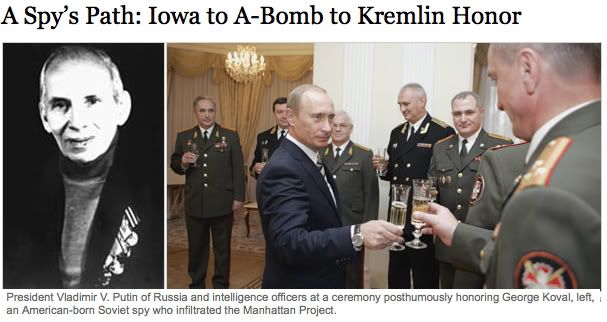
an excerpt from the nytimes of October 2007 also referenced at the National Committee to Reopen the Rosenberg Case
A Spy’s Path: Iowa to A-Bomb to Kremlin Honor
By WILLIAM J. BROAD
He had all-American cover: born in Iowa, college in Manhattan, Army buddies with whom he played baseball.
George Koval also had a secret. During World War II, he was a top Soviet spy, code named Delmar and trained by Stalin’s ruthless bureau of military intelligence.
Atomic spies are old stuff. But historians say Dr. Koval, who died in his 90s last year in Moscow and whose name is just coming to light publicly, was probably one of the most important spies of the 20th century.
On Nov. 2, the Kremlin startled Western scholars by announcing that President Vladimir V. Putin had posthumously given the highest Russian award to a Soviet agent who penetrated the Manhattan Project to build the atom bomb.
The announcement hailed Dr. Koval as “the only Soviet intelligence officer” to infiltrate the project’s secret plants, saying his work “helped speed up considerably the time it took for the Soviet Union to develop an atomic bomb of its own.”
Since then, historians, scientists, federal officials and old friends have raced to tell Dr. Koval’s story — the athlete, the guy everyone liked, the genius at technical studies. American intelligence agencies have known of his betrayal at least since the early 1950s, when investigators interviewed his fellow scientists and swore them to secrecy.
The spy’s success hinged on an unusual family history of migration from Russia to Iowa and back. That gave him a strong commitment to Communism, a relaxed familiarity with American mores and no foreign accent.
“He was very friendly, compassionate and very smart,” said Arnold Kramish, a retired physicist who studied with Dr. Koval at City College and later worked with him on the bomb project. “He never did homework.”
Stewart D. Bloom, a senior physicist at the Lawrence Livermore National Laboratory in California, who also studied with Dr. Koval, called him a regular guy.
“He played baseball and played it well,” usually as shortstop, Dr. Bloom recalled. “He didn’t have a Russian accent. He spoke fluent English, American English. His credentials were perfect.”
Once, Dr. Bloom added, “I saw him staring off in the distance and thinking about something else. Now I think I know what it was.”
Over the years, scholars and federal agents have identified a half-dozen individuals who spied on the bomb project for the Soviets, especially at Los Alamos in New Mexico. All were “walk ins,” spies by impulse and sympathetic leaning rather than rigorous training.
By contrast, Dr. Koval was a mole groomed in the Soviet Union by the feared G.R.U., the military intelligence agency. Moreover, he gained wide access to America’s atomic plants, a feat unknown for any other Soviet spy. Nuclear experts say the secrets of bomb manufacturing can be more important than those of design.
Los Alamos devised the bomb, while its parts and fuel were made at secret plants in such places as Oak Ridge, Tenn., and Dayton, Ohio — sites Dr. Koval not only penetrated, but also assessed as an Army sergeant with wide responsibilities and authority.
“He had access to everything,” said Dr. Kramish, who worked with Dr. Koval at Oak Ridge and now lives in Reston, Va. “He had his own Jeep. Very few of us had our own Jeeps. He was clever. He was a trained G.R.U. spy.” That status, he added, made Dr. Koval unique in the history of atomic espionage, a judgment historians echo.
Washington has known about Dr. Koval’s spying since he fled the United States shortly after the war but kept it secret.
“It would have been highly embarrassing for the U.S. government to have had this divulged,” said Robert S. Norris, author of “Racing for the Bomb,” a biography of the project’s military leader.
Historians say Mr. Putin may have cited Dr. Koval’s accomplishments as a way to rekindle Russian pride. As shown by a New York Public Library database search, the announcement has prompted detailed reports in the Russian press about Dr. Koval and his clandestine feats.
“It’s very exciting to get this kind of break,” said John Earl Haynes, a Library of Congress historian and an authority on atomic spying. “We know very little about G.R.U. operations in the United States.”


























No comments:
Post a Comment